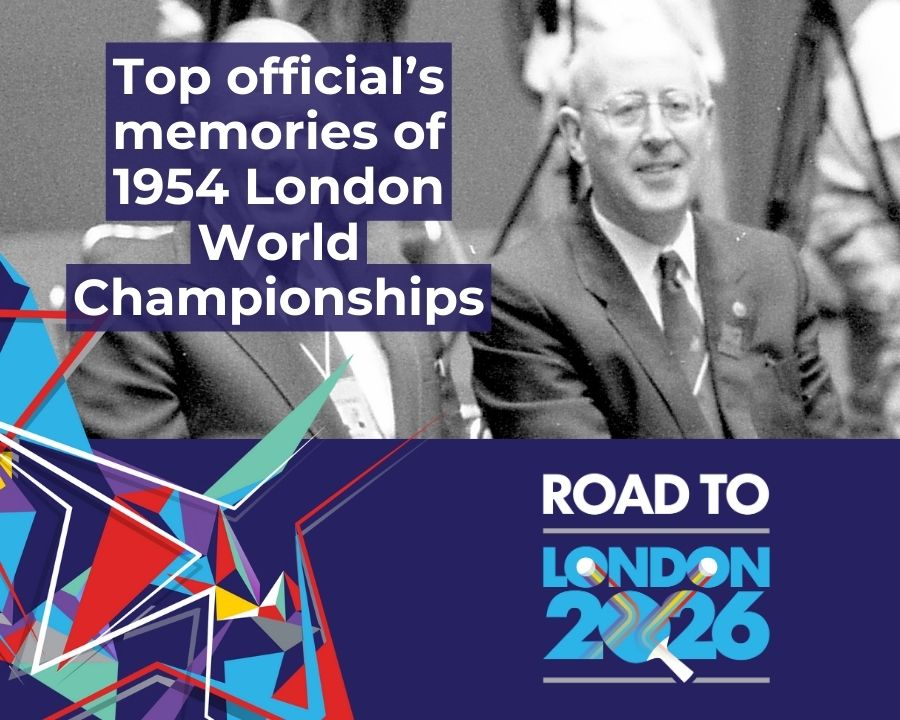It’s fair to say that when it comes to officiating, Colin Clemett is the foremost authority in the table tennis world.
Colin qualified as a County Umpire in 1952 and went on to serve on the Technical Officials Committee for 58 years continuously from 1959 to 2017. He also served on the Rules Committee from 1958-63 and again from 1998 to 2023, including as Chairman from 2007.
How to book your place in the crowd at the 2026 Worlds
Tickets for the 2026 ITTF World Team Championships will go on sale later this year. Click here to register your interest.
Table Tennis England members get priority access to tickets, including our free-of-charge Supporter category of membership. Click here to join.
For the ITTF, he was Secretary of the Rules Committee from 1969 to 1973 and Chair from 1973 to 2003. He was responsible for the introduction of the International Umpire and International Referee qualifications, editor of the Handbooks for Match Officials and Tournament Referees.
Colin making a presentation at the 1985 World Championships in Gothenburg
In addition, he was the Technical Delegate at the 1992, 1996 and 2000 Olympic Games as well as at the 1999 African Games and the 2002 Commonwealth Games in Manchester.
Now aged 96, Colin is one of the few surviving people who played a role at the last World Championships in London, at Wembley in 1954. Below, he shares his memories of the event.
Colin in 2023 with Richard Scruton, who is now Chair of Table Tennis International Events Ltd
I was an umpire at the 1954 World Championships. I had not really expected to be accepted, as I had qualified as a CU only the previous season, and I was thrilled at the prospect of seeing my heroes, such as Viktor Barna and Richard Bergmann, in action up close instead of from a distant spectator seat.
Umpires were organised into squads of three, each led by an experienced umpire as Table Manager. My squad leader was Bill Densham, father of (England international) Terry, the third member being Bill Crozier from Northumberland.
The list of about 100 match officials in the programme covers the usual functions – scorers, stewards, interpreters etc – but for the first and possibly only time, there is no nominated Referee. It was speculated at the time that this was because there were two valuable officials who might expect the position, and that to pick either might be regarded as a slight to the other.
The compromise was to create two hitherto un-named posts of equal status, with Geoff Harrower as Championships Secretary and George White as Director of Play, Referee in all but name.
There is also no mention of two other functions familiar today – Racket Control and Drug Testing. I think that in those more innocent days any suggestion that players might try to gain an unfair advantage by ‘doctoring’ equipment or taking performance-enhancing drugs would have been received with shock and disbelief.
All players and officials were accommodated in the Royal Hotel in Bloomsbury, which was also the administrative headquarters for the Championships.We were taken to and from Wembley every day by bus and there was a half-hour shuttle service all day. Play started at about 9.30 each morning and usually finished at 9 to 9.30 at night, but some matches ended much later.
The arena was set up with all the tables in a line down the centre of the hall. Playing areas were designated by very solid wooden surrounds, and once the Japanese started playing, it was realised that the playing areas were barely big enough for them. It was feared that one might collide with a surround and injure themself. Fortunately, there were no such incidents; I think that for the finals, the playing area was enlarged.
One of my main memories of the hall was that it was very cold, because the wood flooring was laid directly above the ice, which wasn’t melted. It was better when there were plenty of spectators, but it was never really warm and some of the elderly umpires found it distinctly uncomfortable when officiating at matches which, under the time limit rule then in force, could last more than one-and-a-half hours. At that time players were allowed to leave the arena during the intervals between games, but match officials were expected to remain in place throughout.
Colin’s photo of Tage Flisberg congratulating champion Ichiro Ogimura
The most memorable match was the Men’s Singles final, but for the wrong reasons. It was probably the worst Men’s Singles final ever. There were practically no rallies and people simply could not understand why (Tage) Flisberg, who had easily seen off Bergmann in the semi-final, found it so difficult even to return (Ichiro) Ogimura’s service.
Because they were both using thick sponge, play was almost silent and this added to the slightly unreal atmosphere. The whole match, including announcements, introductions, intervals, etc, lasted less than half an hour, a real disappointment.
What helped to compensate was the Women’s Doubles final, with the Rowes (Diane and Rosalind) beating Kathleen Best and Ann Haydon, but It was not as entertaining an evening as might have been expected. I think there were about 10,000 spectators at the finals and that helped to warm the venue up a bit, but it was still quite cold.
There was a farewell party in the Royal Hotel after the finals. It wasn’t a very lavish affair, just a finger buffet and pay-yourself bar and a bit of recorded music for dancing. It ended soon after midnight, but it was quite well attended and people seemed to enjoy it.
The 1954 World Championships budget
Thinking about the budget, the first thing that came to my mind was £15,000. I thought, no, it can’t be. But, of course, with inflation that’s nearly £600,000 today – and the figure was actually £15,203. It was still a fairly austere period in England and rationing had not yet finished.
There was one thing I really remember. It was only about nine years after the Second World War and I think memories of Japanese and German prison camps were still reasonably fresh. Certainly, the popular press was inclined to stir up enmity, so I feared that there were going to be some very embarrassing moments, but it was quite the opposite.
From day one, the camaraderie was amazing. I’ve got some photographs showing, for example, Japanese, French and Yugoslav players clearly enjoying one another’s company while relaxing between matches. The public seemed similarly happy to welcome the players of all nations, and for me this was one of the happiest World Championships.
Colin’s photo of players of different nationalities happy in each other’s company
It also marked the beginning of the end of European dominance of the sport. Players like Bergmann, Barna and (Johnny) Leach were already past their peak and success was beginning to depend more on physical fitness and agility than style.
I feel fortunate to have been able to see at close hand some of the classic stylists of the 40s and early 50s and to witness the dynamic take-over of their successors.
Colin (second right) at the 1991 World Championships along with future Olympic Games referee Stuart Sherlock (centre)
Colin (third from left) and other officials meet the (then) Earl of Wessex and Countess of Wessex at the 2002 Commonwealth Games in Manchester
Discover more from 6up.net
Subscribe to get the latest posts sent to your email.


